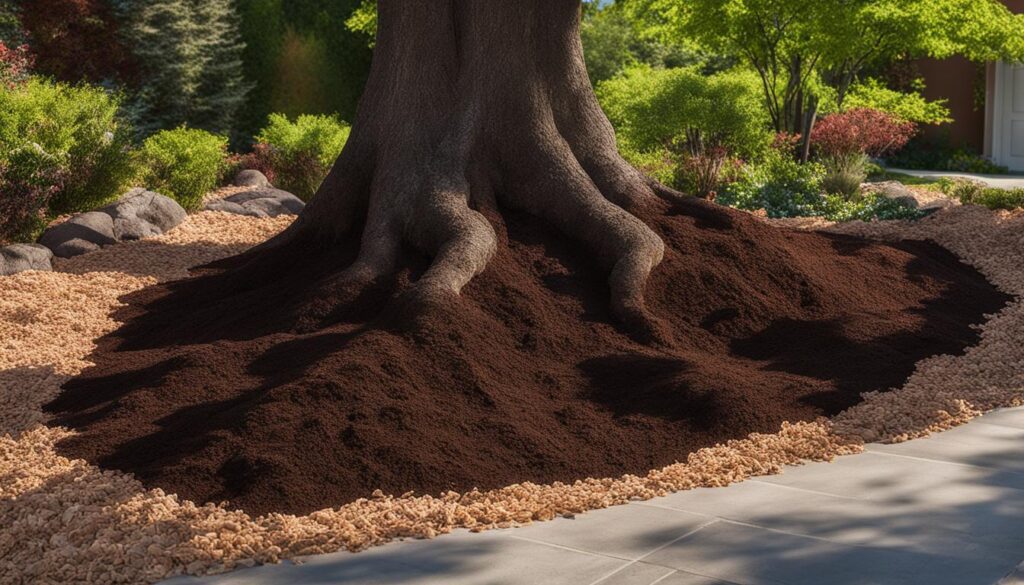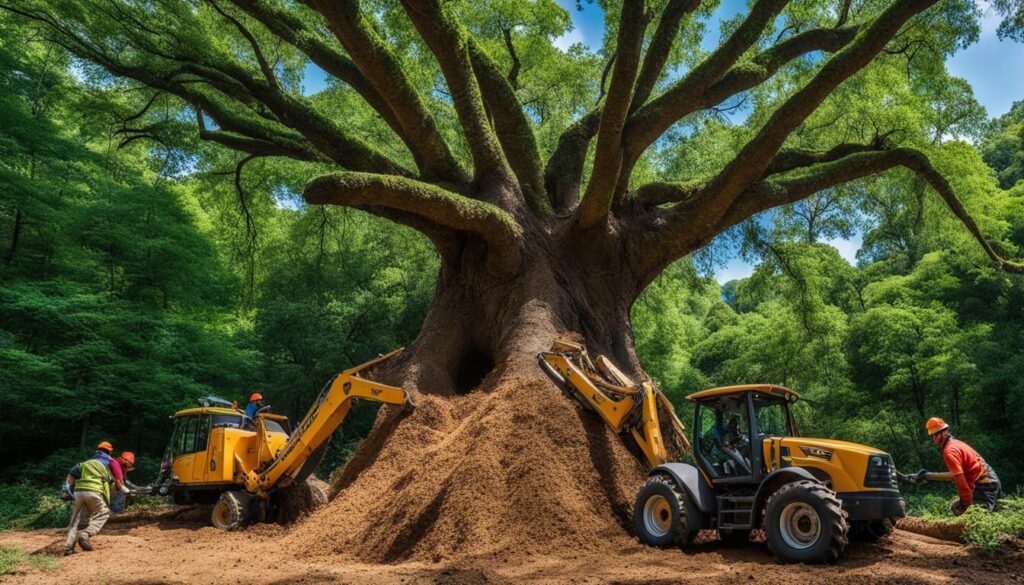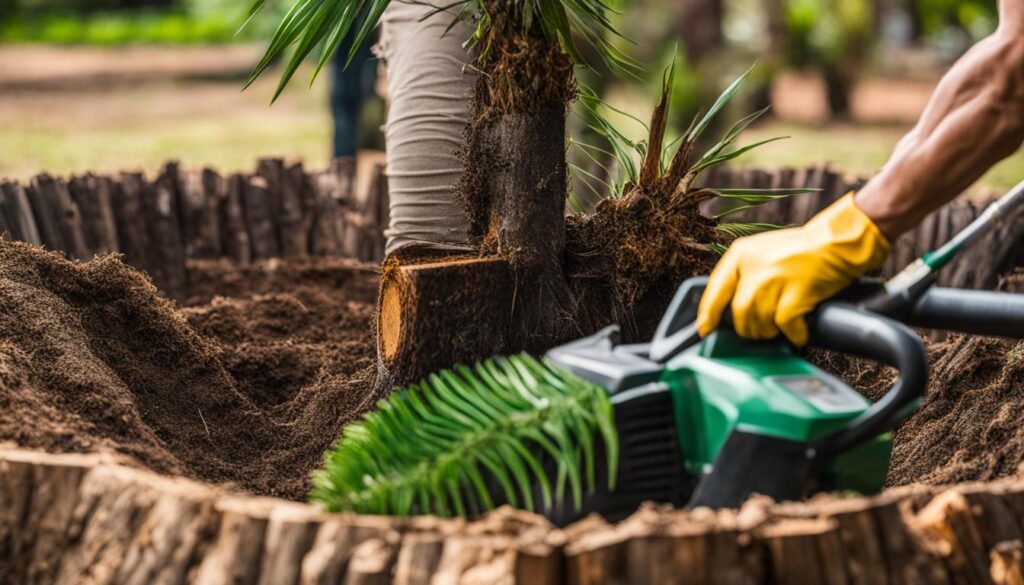As a seasoned gardener and landscape enthusiast, I’ve continually embraced the importance of mulching as a pivotal aspect of tree care. Not merely for its aesthetic value, mulch serves as a fundamental component in fostering tree health and vitality. Insights gained from years of tending to diverse landscapes have shown me that the correct application of mulch around trees can be the differentiating factor between flourishing greenery and a lackluster garden. In this comprehensive mulch guide, I’ll share invaluable tree mulching tips, illustrating how to mulch trees effectively and avoid common pitfalls that could compromise their well-being.
Key Takeaways
- Understand the crucial role of mulch in maintaining tree health and landscape beauty.
- Learn the correct techniques for putting mulch around trees to maximize benefits.
- Grasp the importance of selecting the right mulch type for different tree species.
- Identify and steer clear of common mulching mistakes to ensure the longevity of your trees.
- Discover how to mulch trees in a manner that mimics their natural forest floor habitat.
- Access expert tree mulching tips to enhance soil quality and tree growth.
Understanding the Benefits of Mulching Around Trees
As I explore the world of arboriculture, I’ve come to appreciate how essential mulching is to tree health. Delving into the benefits of mulching trees reveals a myriad of ways in which this single practice can support the vitality of these silent, steadfast giants in our landscapes.
Weed Suppression and Moisture Retention
My initial observations center on mulch’s ability to act as a natural weed barrier. It’s empowering to understand why mulch around trees can significantly hinder the growth of invasive weeds, those unwelcome guests that compete for water and nutrients. This suppressive quality allows for more wholesome allocation of resources, enabling the trees under my care to thrive. Furthermore, mulch enhances moisture retention, a critical component especially in regions susceptible to drought. Maintaining a consistent level of moisture in the soil not only promotes root health but ensures that I’m conserving water—a practice that is both environmentally and economically sound.
Temperature Regulation and Erosion Prevention
Studying further, I’ve found that one of the overlooked benefits of mulching is its role in temperature regulation. An insulating layer of mulch maintains a consistent soil temperature, protecting tree roots from the harsh extremes of summer heat and winter cold. This protective measure leads to a less stressed and more resilient plant. Additionally, erosion prevention emerges as a notable benefit. Mulch acts as a shield, guarding the soil from aggressive rain and winds that can lead to nutrient depletion and root exposure. Ensuring soil stability is paramount for the long-term stability of trees, and mulch is a simple yet effective tool I can use to achieve this.
Mulching for Disease Management in Trees
In my pursuit of promoting tree health, I’ve discovered that mulching also contributes to disease management in trees. It can provide a defensive front against soilborne pathogens, creating a barrier between the tree and the potential hazards lurking in the soil, such as fungal spores. As someone who prioritizes the longevity of trees, realizing that mulching can also mitigate tree damage from landscaping equipment by acting as a buffer zone is particularly compelling. This kind of physical protection is invaluable in landscaped areas where trees might otherwise be vulnerable to accidental injury.
As I continue to apply and advocate for these mulching practices, I’m encouraged by the many ways in which they enhance not only tree health but the ecosystem at large. Embracing the full spectrum of mulching benefits for tree health, from moisture retention and weed suppression to erosion prevention and temperature regulation, allows me to contribute to nurturing our natural surroundings.
Choosing the Right Type of Mulch for Your Trees
As I navigate through the nuances of tree care, I recognize that selecting the ideal mulch is a pivotal decision impacting tree health. The market is flush with mulching options, each offering unique benefits. When choosing right mulch for trees in my landscape, I deliberate on not just the health benefits, but also the contribution to the landscape’s aesthetic and the long-term soil improvement.
Comparing Organic and Inorganic Mulch Options
Organic mulch options, including bark mulch, wood chips, and compost, are my go-to choices for enhancing soil fertility and structure. They slowly decompose, releasing nutrients back into the soil. However, I also consider the practicality of inorganic mulch for specific scenarios. Gravel and rubber, while not providing the same soil enrichment, do offer effective weed control and can be visually striking in a modern garden setting.
Using Living Mulches for Environmental Enhancement
The use of living mulches, such as herbal ground covers like creeping thyme or nitrogen-fixing plants like clover, presents a dynamic option. These are particularly suitable when seeking grass or mulch around trees, as living mulches can cover the ground with greens while still offering the typical benefits of organic mulches, such as soil health and aesthetic appeal.
Mulching Mistakes to Avoid for Tree Health
As someone passionate about gardening, I’ve learned that proper mulching techniques are central to ensuring tree health. Unfortunately, common mulching mistakes can lead to detrimental effects on trees, potentially causing more harm than good. One such error is over-mulching which can result in avoiding mulch volcanoes around trees—a phenomenon where mulch is piled too high around the base, mimicking the shape of a volcano. This can smother the tree’s roots, hinder gas exchange, and invite pests and diseases.
To evade creating a stressful environment for trees, I follow a rule of thumb to never exceed a 2- to 4-inch mulch layer. I also refrain from placing mulch directly against the tree bark, as it can trap moisture, encouraging rot and fungal growth. Instead, a generous space is left around the tree trunk to facilitate proper air circulation.
A key takeaway from my experience is the importance of observing trees after mulching. Signs of distress such as yellowing leaves or slowed growth may indicate an issue with the mulching method used. Quick intervention can save a tree from decline, underscoring why I advocate for mindful mulching practices. By avoiding these pitfalls, we allow our cherished trees to thrive as they anchor and beautify our landscapes.
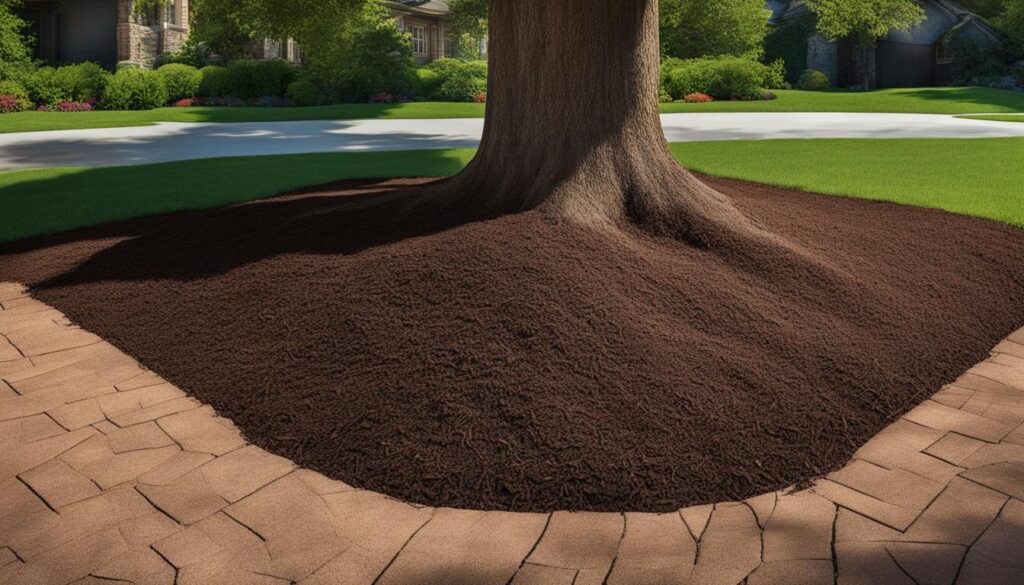

Putting Mulch Around Trees: A Step-by-Step Approach
When I approach the task of mulching around large trees, I understand that it is both an art and a science. Clear communication of the step-by-step mulching process ensures that my trees get the best care possible. Here, I’ll share my methodical strategy for preparing and applying mulch that aligns with the best mulching guidelines for trees.
Preparing the Tree Area for Mulching
My first step is always about creating a clean canvas. I carefully remove any old mulch, weeds, and debris from around the tree’s base. It’s essential to also inspect and trim away any upwards-growing roots to prevent future structural problems. This step is critical as it not only cleans the area but also helps in preventing diseases and promoting the tree’s health.
Appropriate Mulch Application Techniques
I ensure that the mulch I apply is neither too little nor too much. Following the mulching guidelines for trees, I spread a layer of 2 to 4 inches of mulch over a 4 to 5 feet radius surrounding the trunk. Importantly, I leave a gap of about 1 to 2 inches from the tree’s base to prevent moisture buildup and decay. Level distribution is crucial; hence, I spread the mulch evenly to foster proper air circulation and soil oxygenation for optimal root respiration. Preparing trees for mulching meticulously can mean the difference between thriving greenery and landscape complications.
These practices stand as my tried and true approach to how to mulch trees, ensuring their continued health and vibrancy throughout the seasons.
Proper Mulch Depth for Optimum Tree Growth
As someone passionate about gardening and arboriculture, I’ve learned that the secret to optimal tree growth often lies beneath what we can see. The difference between a thriving tree and a struggling one might not be the amount of water or sunlight it gets, but something as simple as the mulch depth for trees. The correct mulching depth is an essential aspect of tree care, as it directly influences the health and stability of their healthy root systems.
My experience and research align with the best practices in the field, where a mulch depth of 2 to 4 inches is the golden standard. This thickness offers an optimal balance by conserving soil moisture, allowing for adequate gas exchange, and regulating temperature—an ideal environment for roots to develop without the risk of suffocation or excess heat. It also reduces the chances of pesky rodents or insects turning the mulch into their new home.
Let’s not overlook how this specific proper mulching depth can safeguard against the development of diseases and fungi that are opportunists, preying on overly moist and ill-maintained mulching setups. Ultimately, what this depth does is mimic the natural layering found in forests—a tried and true method from Mother Nature’s playbook for fostering strong and resilient trees.
I’m always thrilled to share insights that can aid gardeners and environmental enthusiasts to achieve the lush and vibrant landscapes they desire. Remember, when it comes to mulch, more isn’t always better. Strive for that recommended depth, and your trees’ gratitude will be evident in their robust growth and vitality.
Safeguarding Trees with Seasonal Mulching Practices
As a gardener deeply invested in the health of my trees, I recognize the critical role that seasonal mulching plays in their overall well-being. In the many years I’ve spent tending to my garden, I’ve compiled a wealth of mulching tips for trees to ensure they thrive throughout the year. My approach prioritizes not only the maintenance of mulch appearance but also the practical aspects of moisture monitoring and adjusting practices to suit the changing seasons.
Mulching Guidelines for Trees in Different Seasons
When mulching trees in summer, it’s essential to focus on creating a barrier against the intense heat, which can stress root systems. The summer mulch layer I apply is designed to retain moisture without suffocating the roots, providing a moderate and steady temperature around the tree’s base. Conversely, mulching trees in winter involves a different strategy. During the colder months, my goal shifts towards insulating the roots from freezing conditions and preventing heave-thaw cycles that can severely damage root structures. By applying a thicker layer of mulch before the winter sets in, I’m able to offer an extra layer of protection against chilly temperatures.
Importance of Moisture Monitoring for Mulched Trees
Moisture monitoring is integral to the regimen of tree care, particularly when mulch is involved. I diligently check the soil’s moisture levels beneath the mulch to ascertain whether additional watering is required. During the dry spells of summer, the retained moisture from a well-mulched tree base can prove invaluable, and yet, without proper moisture monitoring, the roots could still suffer from dehydration. It’s a delicate balance that I maintain through close observation and timely intervention.
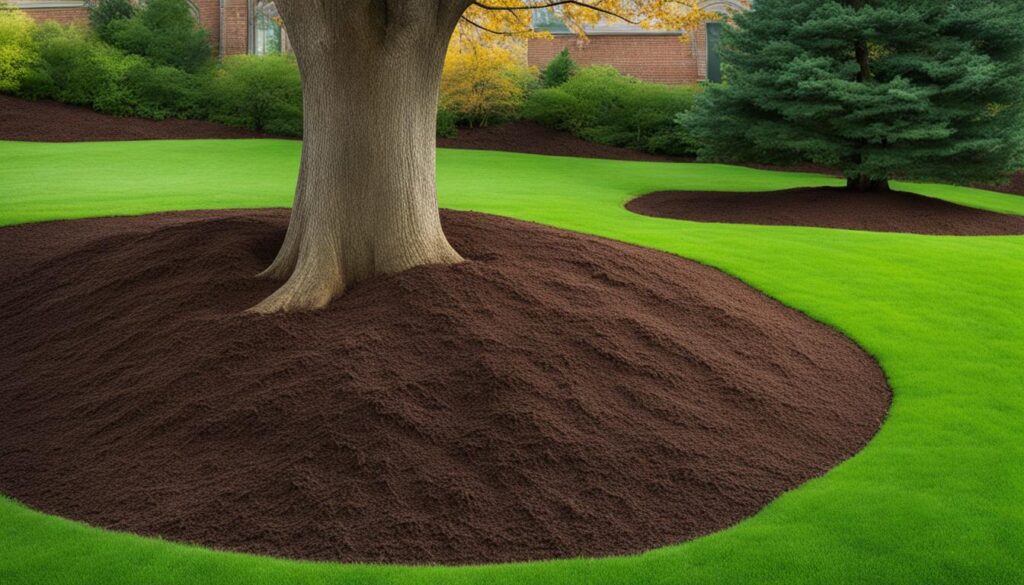

Throughout the seasons, my approach adapts to ensure the depth and quality of the mulch remain consistent, providing continuous support for the natural growth and vigor of the trees. Adhering to these seasonal mulching and moisture monitoring practices, I’ve managed to support and enhance the vitality of my arboreal companions, which continue to decorate my landscape with their robust health.
Putting Mulch Around Trees: Key to Sustained Tree Health
As I explore gardening techniques that promote vibrant ecosystems, I recognize that why mulching is important for trees cannot be overstated. The practice of carefully placing mulch around the base of our woody friends is more than an act of beautification; it’s essential for fostering sustained tree health through mulching. By creating a buffer between the harsh elements and the delicate soil, mulch acts almost as a guardian, moderating soil temperature and ensuring that the moisture trees crave doesn’t vanish with the midday sun.
The mulching benefits for tree health are numerous, including the provision of vital nutrients as organic mulch breaks down over time. This decomposition mirrors the natural process found in forests, which is a perfect paradigm of sustainable vegetation. Moreover, mulching reduces the likelihood of injury from lawn equipment, helping prevent gashes in tree trunks that could invite disease or pests.
My personal experience in mulching has been revelatory. Witnessing the transformation of trees that once appeared languid into flourishing pillars of greenery is inspiring. It conveys a clear message: mulch is more than a mere accessory to landscape. It is a catalyst for health and vitality, enabling trees to achieve their full potential in growth and resilience. This amelioration of their growing conditions leads to a visible testament to the well-being of the entire ecosystem they anchor.
The Environmental Impact of Mulching
As I engage with the world of horticulture, I’ve come to understand the profound influence that mulching has on the environment. The act of mulching extends beyond the simple beautification of our gardens; it plays a crucial role in nurturing the soil and preserving our planet’s precious resources. Today, I’m delving into the remarkable environmental benefits that mulching offers, from enhancing soil structure to conserving water and fostering a dynamic, biodiverse ecosystem.
Soil Improvement and Water Conservation
When we think about mulching for environmental impact, it’s clear that the soil beneath our feet greatly benefits. By introducing a layer of mulch, we enrich the soil with organic matter that decomposes, incorporating essential nutrients and improving soil fertility. This natural process, reminiscent of a forest’s lifecycle, transforms the ground into a fertile bed, supporting robust plant growth. Moreover, my firsthand experience has shown me that with the right mulch, water is conserved efficiently. The mulch acts as a barrier to evaporation, sealing in moisture and dramatically reducing the need for artificial watering, which aligns with sustainable land stewardship practices.
Preventing Soil Compaction and Promoting Biodiversity
In my quest for sustainable gardening, I’ve learned that preventing soil compaction is yet another advantage of regular mulching. A soft layer of mulch buffers the soil from the elements and our footsteps, allowing it to remain porous and aerated—a boon for healthy root development and overall plant vigor. Even more fascinating is observing the uptick in biodiversity through mulching. The mulch layer provides habitat for a plethora of microorganisms, insects, and fungi, each playing a vital role in the soil’s ecosystem. The balance of this biodiversity is instrumental in maintaining natural pest control and promoting a thriving garden.
Alternative Mulching Materials and Their Effectiveness
As I delve into the realm of garden care, my focus shifts towards the utilization of alternative mulching materials which not only benefit the soil but also align with sustainable practices. Exploring beyond conventional choices leads me to consider a variety of both organic and inorganic options that address specific gardening needs while fulfilling an environmental stewardship role.
The quest for alternative mulching materials often begins with items that are readily available and often regarded as waste. Recycled organic matter, sourced from everyday products, presents an eco-friendly solution to mulching needs. I’m particularly impressed with how ordinary newspaper and cardboard, which could otherwise contribute to landfill bulk, can be repurposed effectively as mulch. They suppress weeds superbly and, over time, break down to enrich the soil with organic matter. Even more intriguing are the cocoa bean hulls and seaweed, by-products from the food industry, that I find not only offer nutrient-rich coverage but also introduce an element of novelty to the garden aesthetic.
Utilizing Recycled Organic Matter as Mulch
In my experience, determining the effectiveness of recycled organic matter as mulch depends significantly on how these materials interact with the native soil and plant life. I am pleasantly surprised by the resourcefulness of using grass clippings, for instance. They form a nitrogen-boosting blanket over beds that can substantially promote plant growth. The key to maximizing their benefits lies in their proper deployment; a thin layer prevents the onset of mold and odor problems, promoting a tidy and healthful garden environment.
Innovative Uses of Inorganic Mulching Substances
While organic mulches contribute to the nutrient cycle, inorganic mulching substances draw my attention because of their long-lasting nature and reduced maintenance. Inorganic options such as pebbles, gravel, and even recycled rubber emerge as viable solutions. My investigations reveal that although they do not enhance soil fertility, their efficacy in suppressing weeds and retaining soil moisture is comparable to that of their organic counterparts. Furthermore, they often remain visually appealing over extended periods, thus minimizing the need for frequent replenishment.
In concluding this section of my article, it’s clear to me that alternative mulching materials, including recycled organic matter and inorganic mulching substances, present not only a diverse palette of options for gardeners but also a pathway towards more sustainable practices. Whether it’s the rich aroma of cocoa bean hulls or the marine essence of seaweed as mulch, each offers a unique contribution to gardening that is worth exploring.
Addressing Common Tree Mulching Concerns and Solutions
As a seasoned gardener, I often encounter a host of common tree mulching questions from my peers and community members. One of the primary mulching concerns is identifying the right strategy for mulch around mature trees. One might wonder, “Should I mulch around trees at all?” The answer is a resounding yes, as mulching is crucial for the health and vitality of both young and mature trees. To address these inquiries, I focus on providing tree mulching solutions grounded in best practices.
I recommend annual mulching to sustain nutrient levels and proper mulch depth. When mulching trees, it’s important to consider the unique needs of mature specimens. Their established root systems and potential sensitivity to changes in their environment make careful mulching all the more crucial. Spreading a 2 to 4-inch thick layer of mulch around the base—without allowing it to touch the trunk—provides numerous benefits such as moisture retention, temperature control, and protection against mechanical damage.
Another point to clarify is the use of grass clippings as mulch, which is advisable only if they are free from herbicides. These clippings can be an eco-friendly mulching choice that recycles yard waste while maintaining a lush garden. By making informed decisions like these, gardeners can effectively meet their tree mulching needs and ensure long-lasting tree health.
In sum, whether you’re mulching seedlings or considering mulch around mature trees, understanding and implementing tree mulching solutions is essential. It promotes a thriving garden ecosystem where trees can flourish for years to come.
Conclusion
The importance of mulching cannot be overstated when it comes to cultivating and maintaining vibrant, thriving trees. Throughout this article, I’ve highlighted the essential role that mulch plays in preserving tree health and enhancing the visual appeal of our landscapes. Applying the proper mulching techniques is not only a simple gesture of care but a crucial component of arboriculture. As gardeners and caretakers of the environment, we understand that mulch serves as a protective blanket that simulates the nurturing forest floor—a haven for growth and vitality.
Adhering to mulching guidelines ensures that we do not fall prey to common errors that could otherwise compromise a tree’s well-being. It’s my responsibility to select the ideal mulching material and meticulously apply it around each precious sapling and towering oak, keeping in mind that the benefits extend beyond aesthetics. Seasonal adjustments and the exploration of alternative mulching substances further amplify our ability to provide an optimum growing environment.
Ultimately, my commitment to these practices fosters a robust landscape that not only flourishes in my care but contributes positively to the greater ecosystem. The journey from a novice tree planter to a savvy steward of nature has taught me the value of each step in the mulching process. By sharing my knowledge and experience here, I hope to inspire others to embrace the art and science of mulching, for the love of trees and the earth we all share.
FAQ
Why is it important to mulch around trees?
Mulching around trees provides numerous benefits including moisture retention, temperature regulation for roots, weed suppression, erosion prevention, and disease management. It creates favorable growing conditions, mirroring a tree’s natural forest environment.
What is the best mulch for my trees?
The best mulch for your trees depends on various factors including tree species, climate, soil conditions, and aesthetic preferences. Organic mulches like bark, wood chips, pine needles, and compost mixes are commonly used for their soil-enriching properties. For those who prefer inorganic options, gravel and rubber mulch can be a good choice for weed control without the need for frequent replacement.
Should I mulch around mature trees as well as younger ones?
Yes, mulching is beneficial for both young and mature trees. While younger trees may need mulch to help establish root systems and protect from mechanical damage, mature trees still benefit from the moisture retention, temperature regulation, and biological activity that mulch encourages.
How often should I replace mulch around my trees?
Mulch should be checked annually and replenished as needed to maintain a 2-4 inch depth. However, it’s not always necessary to remove the old mulch; simply break up any matted layers and add fresh mulch on top, unless there are signs of disease or the mulch is adversely affecting the soil.
Can I just leave grass around my trees instead of mulching?
While you can leave grass around trees, mulch is generally preferred as it provides a clear area that reduces competition for nutrients and water. Grass can also encourage the growth of pests and diseases near the tree base, which mulch helps to prevent.
How do I properly mulch around trees?
To properly mulch around trees, first remove any grass and weeds and clear away old mulch and debris. Apply a 2-4 inch layer of mulch in a wide ring around the tree, avoiding the tree trunk to leave a gap for air circulation. Ensure the mulch layer is even and not mounded against the tree base.
Is it possible to over-mulch around trees?
Yes, over-mulching can harm trees by creating a “mulch volcano” that traps excessive moisture and can lead to root rot, fungal growth, and insect problems. To prevent this, maintain the recommended depth of 2 to 4 inches and avoid piling mulch against the trunk of the tree.
Are there mulching considerations for different seasons?
Mulching in different seasons involves refreshing mulch during spring to maintain proper depth and before winter for protective coverage. It’s crucial to monitor moisture levels throughout the year, as mulch retains water but may necessitate additional watering during dry spells.
How does mulching impact the environment?
Mulching improves the environment by adding vital organic matter and nutrients to the soil, conserving water by reducing evaporation, preventing soil compaction for better root growth, and supporting biodiversity by creating habitats for beneficial microorganisms.
Can I use alternative materials like newspaper or cardboard as mulch?
Yes, alternative organic materials like newspaper, cardboard, cocoa bean hulls, and grass clippings can be used as mulch. These materials act as effective weed barriers and enrich the soil as they decompose. Inorganics like rocks or rubber are also options but do not improve soil fertility.

